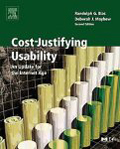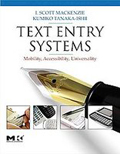User Interface Design
and Evaluation
Debbie Stone
Caroline Jarrett
Mark Woodroffe
Shailey Minocha
ISBN: 9780120884360
Copyright 2005
User Interface Design and Evaluation presents an overview of the user-centered design field. It illustrates the benefits of a user-centered approach to the design of software, computer systems, and web sites. This book provides a clear and practical discussion of requirements gathering; developing interaction design from user requirements; and user interface evaluation. The book's coverage includes established HCI topics—such as visibility, affordance, feedback, metaphors, mental models, and the like—combined with practical guidelines for contemporary designs and current trends. You get a clear presentation of ideas, illustrations of concepts, using real-world applications. User Interface Design and Evaluation will help you develop all the skills necessary for iterative user-centered design, and provides a firm foundation for user interface design and evaluation on which to build.... [more]
Understanding Mobile Human-Computer Interaction
Steve Love
ISBN: 9780750663526
Copyright 2005
Taking a psychological perspective, Understanding Mobile Human-Computer Interaction examines the role of Human-Computer Interaction in the field of Information Systems research. The introductory section of the book covers the basic tenets of the HCI discipline, including how it developed and an overview of the various academic disciplines that contribute to HCI research. The second part of the book focuses on the application of HCI to Information Systems research, and reviews ways in which HCI techniques, methodologies and other research components have been used to date in the IS field. The third section of the book looks at the research areas where HCI has not yet been fully exploited in relation to IS, such as broadening user groups and user acceptance of technology. The final section of the book comprises of a set of guidelines for students to follow when undertaking an HCI based research project.. [more]
 Cost-Justifying
Usability, 2nd Edition
An Update for the Internet Age
Randolph Bias
Deborah Mayhew
ISBN: 9780120958115
Copyright 2005
In this completely revised and new edition of Cost-Justifying Usability, Randolph G. Bias (University of Texas at Austin, with 25 years’ experience as a usability practitioner and manager) and Deborah J. Mayhew (internationally recognized usability consultant and author of two other seminal books including The Usability Engineering Lifecycle) tackle how to gain buy in for usability projects. It has been updated to cover cost-justifying usability for Web sites and intranets, for the complex applications we have today, and for a host of products—offering techniques, examples, and cases that are unavailable elsewhere No matter what type of product you build, whether or not you are a cost-benefit expert or a born salesperson, this book has the tools that will enable you to cost-justify the appropriate usability investment... [more]
Effective
Prototyping for Software Makers
Jonathan Arnowitz
Michael Arent
Nevin Berger
ISBN: 9780120885688
Copyright 2006
Much as we hate to admit it, most prototyping practice lacks a sophisticated understanding of the broad concepts of prototyping—and its strategic position within the development process. Often we overwhelm with a high fidelity prototype that designs us into a corner. Or, we can underwhelm with a prototype with too much ambiguity and flexibility to be of much use in the software development process. Effective Prototyping for Software Makers will help software makers—developers, designers, and architects—build effective prototypes every time: prototypes that convey enough information about the product at the appropriate time and thus set expectations appropriately... [more]
GUI Bloopers 2.0
Common User Interface Design Don'ts and Dos
Jeff Johnson
ISBN: 9780123706430
Copyright 2007
A major revision of a classic reference, GUI Bloopers 2.0 looks at user interface design bloopers from commercial software, Web sites, Web applications, and information appliances, explaining how intelligent, well-intentioned professionals make these mistakes—and how you can avoid them. While equipping you with the minimum of theory, GUI expert Jeff Johnson presents the reality of interface design in an entertaining, anecdotal, and instructive way... [more]
Information Visualization, 2nd Edition
Perception for Design
Colin
Ware
ISBN: 9781558608191
Copyright 2005
Information Visualization combines a strictly scientific approach to human perception with a practical concern for the rules governing the effective visual presentation of information. Surveying the research of leading psychologists and neurophysiologists, author Colin Ware isolates key principles at work in vision and perception, and from them derives specific and effective visualization techniques suitable for a wide range of scenarios. Information Visualization offers practical guidelines that can be applied by anyone, and covers all facets of visual perception: color, organization, space perception, motion, and texture... [more]
Letting Go of the Words
Writing Web Content That Works
Janice (Ginny) Redish
ISBN: 9780123694867
Copyright 2007
Letting Go of the Words helps you write successfully for web users. It offers strategy, process, and tactics for creating or revising content for the web. It helps you plan, organize, write, design, and test web content that will make web users come back again and again to your site. Learn how to create usable and useful content for the web from the master − Ginny Redish. Ginny has taught and mentored hundreds of writers, information designers, and content owners in the principles and secrets of creating web information that is easy to scan, easy to read, and easy to use... [more]
Rapid Contextual Design
A How-to Guide to Key Techniques for
User-Centered Design
Karen Holtzblatt
Jessamyn Wendell
Shelley Wood
ISBN: 9780123540515
Copyright 2004
Rapid Contextual Design introduces Rapid CD, a fast-paced, adaptive form of Contextual Design. Rapid CD is a hands-on guide for anyone who needs practical guidance on how to use the Contextual Design process and adapt it to tactical projects with tight timelines and resources. Rapid Contextual Design provides detailed suggestions on structuring the project and customer interviews, conducting interviews, and running interpretation sessions. The handbook walks you step-by-step through organizing the data so you can see your key issues, along with visioning new solutions, storyboarding to work out the details, and paper prototype interviewing to iterate the design—all with as little as a two-person team with only a few weeks to spare!... [more]
Sketching User Experiences
Getting the Design Right and the Right
Design
Bill Buxton
ISBN: 9780123740373
Copyright 2007
Sketching User Experiences approaches design and design thinking as something distinct that needs to be better understood—by both designers and the people with whom they need to work— in order to achieve success with new products and systems. So while the focus is on design, the approach is holistic. Hence, the book speaks to designers, usability specialists, the HCI community, product managers, and business executives. There is an emphasis on balancing the back-end concern with usability and engineering excellence (getting the design right) with an up-front investment in sketching and ideation (getting the right design). Overall, the objective is to build the notion of informed design: molding emerging technology into a form that serves our society and reflects its values. Grounded in both practice and scientific research, Bill Buxton’s engaging work aims to spark the imagination while encouraging the use of new techniques, breathing new life into user experience design... [more]
 Text Entry Systems
Mobility, Accessibility, Universality
I. Scott MacKenzie
Kumiko Tanaka-Ishii
ISBN: 9780123735911
Copyright 2007
The variety is not just in the devices, but also in the technologies used: Entry modalities have become more varied and include speech recognition and synthesis, handwriting recognition, and even eye-tracking using image processing on web-cams. Statistical language modeling has advanced greatly in the past ten years and so therein is potential to facilitate and improve text entry—increasingly, the way people communicate. Text Entry Systems consists of four parts, and covers these areas: Guidelines for Designing Better Entry Systems (including research methodologies, measurement, and language modelling); Devices and Modalities; Languages of the world and entry systems in those languages; and variety in users and their difficulties with text entry—and the possible design and guideline solutions for those individual user groups.... [more]
The
Mobile Connection
The Cell Phone's Impact on Society
Richard Ling
ISBN: 9781558609365
Copyright 2004
Based on research conducted in dozens of countries, this insightful and entertaining book examines the once unexpected interaction between humans and cell phones, and between humans, period. The compelling discussion and projections about the future of the telephone should give designers everywhere a more informed practice and process, and provide researchers with new ideas to last years..... [more]
The
Persona Lifecycle
Keeping People in Mind Throughout Product
Design
John Pruitt
Tamara Adlin
ISBN: 9780125662512
Copyright 2006
If you design and develop products for people, this book is for you. The Persona Lifecycle addresses the “how” of creating effective personas and using those personas to design products that people love. It doesn’t just describe the value of personas; it offers detailed techniques and tools related to planning, creating, communicating, and using personas to create great product designs. Moreover, it provides rich examples, samples, and illustrations to imitate and model. Perhaps most importantly, it positions personas not as a panacea, but as a method used to complement other user-centered design (UCD) techniques including scenario-based design, cognitive walkthroughs and user testing... [more]
Keeping
Found Things Found
The Study and Practice of Personal Information Management
William P. Jones
ISBN: 9780123708663
Copyright 2008
WE ARE ADRIFT IN A SEA OF INFORMATION. We need information to make good decisions, to get things done, to learn, and to gain better mastery of the world around us. But we do not always have good control of our information - not even in the "home waters" of an office or on the hard drive of a computer. Instead, information may be controlling us - keeping us from doing the things we need to do, getting us to waste money and precious time. Keeping Found Things Found provides a comprehensive guide to Personal Information Management (PIM), which refers to both the practice and the study of the activities people perform in order to acquire, organize, maintain, and retrieve information for everyday use... [more]
Visual
Thinking
for Design
Colin Ware
ISBN: 9780123708960
Copyright 2008
In Visual Thinking for Design, Colin Ware takes what we now know about perception, cognition, and attention and transforms it into concrete advice that designers can directly apply. He demonstrates how designs can be considered as tools for cognition - extensions of the viewer’s brain in much the same way that a hammer is an extension of the user’s hand. This book, grounded in the current science of human perception, is key to helping the creators of visual systems do their best work. Experienced professional designers and students alike will learn how to maximize the power of the information tools they design for the people who use them... [more]
|
|






